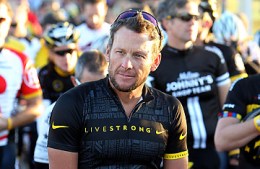
DRIPPING SPRINGS, TX - OCTOBER 15: Seven time Tour De France winner Lance Armstrong waits at the starting line during his Team Livestrong Challenge bike ride on October 15, 2011 in Dripping Springs, Texas. (Photo by Gary Miller/FilmMagic)
When you are the greatest athlete in your sport and one of the most visible figures in the worldwide fight against cancer, you have a lot to protect. Seven-time Tour de France winner Lance Armstrong is used to staying ahead of the pack, but persistent allegations of doping — what the cyclist has called an “unconstitutional witch hunt” against him by the United States Anti-Doping Agency — have finally forced him to the side of the road. “I have been dealing with claims that I cheated and had an unfair advantage in winning my seven Tours since 1999,” he said in a statement released Friday. “The toll this has taken on my family and my work for our foundation and on me leads me to where I am today — finished with this nonsense.”
For choosing not to contest the charges, the USADA has slapped Armstrong with a lifetime ban from the sport and has revoked his Tour de France titles. But while he says he’s moving past the verdict and that he “will no longer address this issue, regardless of the circumstances,” Armstrong’s troubles may not be over. The USADA reportedly has a plethora of witnesses and evidence lined up ready to outline his alleged use of a variety of performance-enhancing drugs, including data they say points to illicit blood doping during his 2009 comeback. And while Armstrong and his supporters have vehemently spoken out against USADA for the singlemindedness with which they’ve persecuted him, that doesn’t mean that their alleged evidence won’t prove damaging if — or more likely when — it ever comes out.
(MORE: Lance Armstrong: Was He Doping or Experimenting with Science?)
Armstrong is at the untenable position that is reached when the alleged evidence against an athlete, regardless of the truth behind it, has hit critical mass. And as history shows, athletes who have gotten used to his kind of dominance and longevity usually fight to the bitter end. Roger Clemens was called to a Congressional hearing to discuss his alleged steroid use, and his defiance led to perjury and obstruction charges that the pitcher had to endure for years. Barry Bonds, baseball’s all-time homerun leader, danced around similar drug charges, playing the plausible deniability and ignorance card until years of dispute ultimately ended in a guilty verdict for obstruction.
But if Armstrong had taken a page out of the Clemens or Bonds playbook and fought the charges against him to the death, the battle would damage more than just his reputation: it could have tainted his massive Livestrong charity, which at this point has raised more than $470 million for those affected by cancer. By deciding not to contest the USADA’s charges he seems to have made the tactical decision to live to fight another day, keeping the testimony and evidence the USADA has amassed from coming to public light — for now.
(MORE: How Lance Armstrong Lost His Seven Tour de France Titles)
Travis Tygart, CEO of USADA, continues to maintain that the organization will publish its full case against Armstrong soon enough. And there may be others with a personal agenda or axe to grind coming out of the woodwork, bearing their own allegations. But one way or another, whatever USADA has on him will get out there, and Armstrong will have to be ready for anything. The time he has taken to avoid direct and ongoing conflict with USADA will be his time to regroup and find a way to preserve and support his denials and his charitable work. Luckily, he has a long list of powerful supporters from the great work that has been done due to his service. Many of his biggest sponsors, including Nike, have said they would stand by him in the wake of the USADA decision. And he still has widespread popular support — donations to Livestrong soared in the wake of Friday’s news. But if the evidence, when it comes out, is insurmountable, it could damage his movement as much as his reputation. And that would be unfortunate for a lot of people who believe in “living strong.”
Just in case, now is a good time for Armstrong to start thinking about how to pass on his legacy and assess whether Livestrong, and all the good work it does, can exist without him. As last Friday’s donation surge shows, right now there’s a lot of goodwill towards Lance Armstrong and his cause. But that was only one day. And he needs a lifetime.
